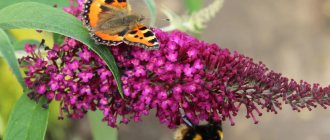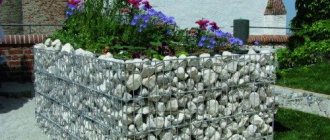Flowering plants in the shade are always perceived as a small miracle. It is believed that decorative deciduous crops dominate in the secluded corners of the garden, but the profusely flowering stars can be literally counted on one hand. But, in fact, the range of plants that bloom beautifully in poor lighting is not so small. Unique accents for shady corners of the garden include uvularia, an unusual large-leaved perennial with bright yellow drooping flowers.
Grandiflora uvularia (Uvularia grandiflora) in a flower garden. © Arild Bjørnsen
Uvularia - sun in the shade
Herbaceous perennials offer so much choice between different types of flowering, shape and structure of flowers and inflorescences that it is very difficult to surprise with something truly new. But the flowering of uvularia cannot be called anything other than non-standard and original. This plant has drooping, unusual flowers that give the impression of rare sophistication. It will be difficult to find another such plant, combining shade-loving with non-standard flowering and original details and at the same time remaining an almost wild crop, as if it had just been transported from the forest thickets.
Uvularia is a unique North American plant that came to us from the subtropical and warm-temperate climate of the Eastern USA and Canada. But despite this origin, this plant is hardy and winter-hardy enough to be grown as a perennial even in the conditions of our middle zone. The name “uvularia” comes from the Latin “uvula” - “tongue”: the narrow flowers that droop on the peduncles of this plant look like thin tongues.
Uvularia are quite powerful herbaceous perennials. These plants are limited in height to half a meter, although in their homeland they can be larger. Usually they develop in the form of constantly expanding bushes and form entire thickets, the bottom of the shoots is never exposed, the plant is attractive throughout the crown. Uvularia form horizontally spreading, not too deep and densely branched rhizomes. The shoots are numerous and very thin, hidden by a sheath at the base, forked at the top, creating stunningly dense bushes, despite the sparsely located large leaves. Each shoot most often has only 2-4 leaves. The leaves of uvularia hug the stem or are sessile, slightly fluffy on the underside, reach a length of up to 10 cm and boast an almost perfect lanceolate-elliptic or elliptical shape. The color of the greenery is very bright, light green, with a warm yellowish tone.
The amazing flowers of all uvularia bloom at the ends of the shoots. Most often, plants produce single flowers, although sometimes paired inflorescences are also found. A distinctive feature of uvularia flowers is a narrow bell-shaped corolla, deeply dissected into 6 thin yellow petal leaves, which from a distance are perceived almost as ribbon-like. Thanks to this cross-section and elongated shape, the flowers seem very unusual. In some types of uvularia, their shape is also emphasized by narrow bracts that almost repeat the outline of the flowers. At the base of the perianth there are nectaries and thin filaments that harmonize perfectly with the linear anthers. The half-fused styles and three-lobed ovary are difficult to see. After flowering, triangular three-winged capsule fruits are formed, which burst at the top when the seeds ripen.
Traditionally, the flowering period of uvularia lasts only a few weeks. If the weather is favorable, the plants bloom already in mid-spring; if the spring is cold, then only at the end of May.
The color range of this perennial is limited exclusively to yellow colors.
Uvularia. © Gloria
Features of culture
The spread of uvularia (genus Colchicumaceae) as a garden crop is facilitated by its elegant, sophisticated appearance and ability to bloom in partial shade, forming beautiful decorative meadows. The growth occurs due to the horizontal branched root system, which lies shallow. The rhizome secretes mucus and has a specific odor.
The upper part of a thin straight branching shoot, growing from 30 to 60 cm in height, is covered with sessile or entwining leaves (2-4 pieces). The bright green leaf is large, long (up to 10 cm), elliptical or lanceolate in shape.
The name of the genus comes from the Latin word “uvula”, which means “tongue” - the narrow petals look like yellow tongues.
Drooping flowers, cream or various shades of yellow, solitary, rarely paired, formed at the top of the shoot or in the leaf axils. Their shape is similar to a drooping bell with long narrow slightly curled petals (there are six of them). Some species have bracts, almost repeating the shape of the flower, leaves. Flowering, beginning in late April or May, continues until July. The seeds are formed in a triangular, three-winged capsule, which bursts when the grains are completely ripe.
Types of uvularia
The genus uvularia cannot boast of great diversity. There are 5 species of this plant found in nature, of which only 3 species are used as cultivated plants.
The most popular type of uvularia, characterized by the most beautiful flowering, is the grandiflora uvularia (Uvularia grandiflora). This is a North American plant, accustomed to living in deciduous forests and characterized by increased bushiness. It produces thin but numerous stems that embrace pairs of pointed-elliptical leaves up to 10 cm long. At the ends of the shoots, up to three flowers with a bright yellow color droop on long stalks. The length of the bells reaches 4 cm. This type of uvularia traditionally blooms in mid-May and by June flowering stops.
Sessile uvularia (Uvularia sessilifolia) is the most compact of the representatives of the genus, forming quite dense but low bushes up to 30 cm in height. The leaves are sessile, which served as the basis for the name of the species, oval-elongated, up to 8 cm in length, they are distinguished by rough edges. The flowers, despite their length of only 3 cm, are very impressive. The greenish-yellow tint of color and the pointed shape of the narrow lobes, combined with shortened stamens, perfectly reveal the wild character of this plant. The fruit capsules are not triangular, but ovoid. This is the longest-blooming species of uvularia, which can bloom tirelessly from mid-spring to early summer.
lover of damp places and the company of shrubs. It is very similar to grandiflora uvularia, but differs in thinner and more graceful shoots, slightly wider, perfectly elliptical leaves. The light yellow, narrow, drooping bells of the flowers reach only 2-3 cm in length, blooming singly or in pairs on each branch of the shoot. The species pleasantly surprises with its fragrant nature, but it blooms only at the end of May and for only 1.5-2 weeks.
Grandiflora uvularia (Uvularia grandiflora). © davisla
Sessile uvularia (Uvularia sessilifolia). ©Tom Todd
Uvularia perfoliata. © Caerulean Skies
In garden design, uvularia is used:
- for shady flower beds;
- for narrow ribbon mixborders under hedges and in the foreground of hedges;
- for camouflaging the base of shrubs, in the edges and undergrowth for shrub plants;
- in the design of shaded areas near water bodies;
- as a border crop along the path;
- in landscape areas and groups;
- as highlighting accents in too dark corners;
- in decorative compositions in sunny or light areas, provided that shrubs or perennials create sufficient shade;
- as a partner for shrubs that prefer acidic soils, including in complex compositions with rhododendrons;
- in design with a focus on yellow color (to add yellow accents to shady areas of the garden).
The best partners for uvularia: aquilegia, astilbe, ferns, hosts, rhododendrons, heathers.
Uvularia
Decorating the garden with a plant
Uvularia is one of the few flowers that can bloom even in the shade. This feature of the plant allows gardeners to decorate even the most shaded places in the garden with it. Uvularia is planted along paths and decorates the coasts of artificially created reservoirs. The overgrown bushes look spectacular, despite the end of flowering, and the yellowed foliage goes well with the dark green neighboring plants.
The culture looks great in combination with aquilegia, bergenia, fern, heather, astilbe, and swimsuit. The plant also decorates the bases of rhododendrons and conifers - thujas, cypresses, spruces, junipers, barberries.
Conditions required for uvularia
Choosing a comfortable platform for uvularia is quite simple. This plant can settle only in shady places, under the protection of shrubs and trees.
While it’s quite easy to choose lighting for this plant, with soils it’s not so simple. These are moisture-loving plants that love fresh, well-moistened soils. A loose soil structure for uvularia is a prerequisite, but uvularia cannot tolerate too light soil. Heavy soil is improved by adding sand, and too light soil is corrected by adding clay. Uvularia can only grow in places with slightly acidic soil; it is a good partner for garden plants that prefer acidic conditions. Caring for uvularia
This is a moisture-loving plant that does not respond well to drought. For uvularia, it is desirable to ensure constant soil moisture by introducing watering into the care program in the absence of natural precipitation (systemic procedures are useless: watering for this plant can be done quite rarely, but provided that the soil is deeply saturated with water). There is one more nuance: moisture-loving behavior is characteristic of uvularia only until mid-summer. From the end of July, all uvularia become drought-resistant and hardy; they do not need additional watering.
Feeding for this plant is very important. It is advisable to carry out the first feeding of uvularia during planting by adding mineral fertilizers to the soil. In the future, annually it is necessary to apply at least one fertilizing with complete mineral fertilizer in a standard dosage (in early spring or after flowering, and if possible - twice). To prepare for winter in the fall, uvularia can be fed with a special fertilizer (but not phosphorus-potassium, as for most herbaceous perennials, but pure potassium).
Uvularia do not need any other care, they are not suppressed by weeds, and the plant independently clears itself of fading flowers.
Diseases and pests
If the soil under the uvularia bush has become too wet, this can cause the appearance of slugs or snails in the area, which pose a threat to the garden plant.
Young plantings are most susceptible to attack by these pests. If planting conditions are not met, the plant may be attacked by fungal diseases, such as powdery mildew. To avoid problems during the flowering period, it is recommended to treat the bushes with fungicides .
Affected plants are removed from the site and disposed of to prevent the infection from spreading to neighboring bushes.
Wintering of uvularia
All three types of cultivated uvularia are quite winter-hardy and do not require shelter under normal winter conditions. In snowless winters, only uvularia pierced-leaved will not need protection. The other two species (Uvularia grandiflora and sessile foliage) require cover with a dry leaf to stabilize conditions.
Grandiflora uvularia (Uvularia grandiflora). © Alan Jolliffe
Recommendations
- " Uvularia grandiflora
." Natural Resources Conservation Service PLANTS Database. USDA. Retrieved September 22, 2022. - RHS AZ Encyclopedia of Garden Plants
. United Kingdom: Dorling Kindersley. 2008. p. 1136. ISBN 978-1405332965. - Timothy P. Spira (May 16, 2011). Wildflowers and Plant Communities of the Southern Appalachians and Piedmont: A Naturalist's Guide to the Carolinas, Virginia, Tennessee and Georgia
. Univ of North Carolina Press. P. 462–. ISBN 978-0-8078-7765-4. - Harrison, Lorraine (2012). RHS Latin for Gardeners
. United Kingdom: Mitchell Beasley. ISBN 978-1845337315. - ^ a b
"
Uvularia grandiflora
". Natural Resources Conservation Service PLANTS Database. USDA. Retrieved December 19, 2022. - Utech, Frederick H.; Kawano, Shoichi (2002). " Uvularia grandiflora
."
In Flora of the North American Editorial Committee (ed.). Flora of North America north of Mexico (FNA)
.
26
. New York and Oxford - via eFloras.org, Missouri Botanical Garden, St. Louis, MO, Harvard University Herbaria, Cambridge, MA. - Charlotte Adelman; Bernard L. Schwartz (September 21, 2011). The Midwest Native Garden: Native Alternatives to Non-Native Flowers and Plants
. Ohio University Press. P. 77–. ISBN 978-0-8214-4356-9. - "Endangered, Threatened, and Species of Special Concern in Connecticut, 2015." (PDF). Connecticut Department of Energy and Bureau of Natural Resources Environmental Protection. Retrieved January 1, 2022. (Note: This list is newer and updated than that used at plant.usda.gov)
- Smith, Huron H. (1923). "Ethnobotany of the Menominee Indians". Bulletin of the City of Milwaukee Public Museum
.
4:41
. - Smith, Huron H. (1932). "Ethnobotany of the Ojibwe Indians". Milwaukee Public Museum Bulletin
.
4
: 374. - Smith, Huron H. (1933). "Ethnobotany of the Woodland Potawatomi Indians". Bulletin of the City of Milwaukee Public Museum
.
7
: 56, 57, 64. - "RHS Plant Selector - Uvularia grandiflora
." Retrieved April 15, 2022. - "AGM Plants - Ornamental" (PDF). Royal Horticultural Society. July 2022. p. 106. Received January 10, 2010.
- Born, Val. "Merry bells" Daily Telegraph. Retrieved May 4, 2013.
Reproduction of uvularia
Uvularia can be propagated both vegetatively and by seeds. But the latter method is rarely used due to the fact that the plant blooms only in the third year after sowing (and sometimes only after 5 years). Seeds are sown directly into the soil before winter or in early spring (the next year after collection). They do not require pre-sowing treatment; the crops, provided that constant soil moisture is maintained, develop evenly, but very slowly; the growing process requires considerable patience.
The plant is propagated vegetatively by dividing the bushes. At the same time, it is not necessary to take large cuttings for uvularia: most often, plants are propagated using a simple piece of rhizome with one renewal bud. A prerequisite for successful rooting is treating the wounds with crushed charcoal or fungicide. Uvularia are rooted in a special separate bed or immediately in a permanent place, maintaining constant soil moisture and preventing it from drying out. Vegetative propagation of plants can be done both in early spring and at the end of summer.
Uvularia for medicinal and landscape purposes
Plant type: perennial, herbaceous.
Description: representative of the lily family. In the wild, this hardy plant has a wide range of habitats. Uvularia mainly grow in moist forests, and gardeners often transplant them into gardens and then propagate them by division. The not yet formed rhizome is slimy and has a pungent odor. The main stem at the apex is usually divided into two parts. They bloom in the spring and are often planted under deciduous trees; this location produces the most spectacular flowering. The plant reaches a height of 30 to 60 cm.
- Homeland: North America.
- Growing environment: garden or greenhouse.
- Care: Uvularia are easy to care for.
- Lighting: shade or partial shade is best for uvularia.
- Growth rate: average.
- Aroma: none.
Flowering: in spring. The hanging flowers are single and have a green-yellow hue, and their size is from 2 to 5 cm. The flowering period is from April to June. Uvularia flowers are hermaphrodite and are pollinated by a variety of insects.
Foliage: compressed or stemless, smooth, elliptical in shape, rounded at the base. The length of the leaves is from 5 to 7 cm. On the inside it has a grayish-green tint.
Soil Type: Requires well-drained, slightly acidic soil. Loams are best suited. For the best effect, sand should be added to the soil. To improve drainage, amend the soil with compost or manure 7-10 days before planting.
Fertilizers: Uvularia will grow well if there is a large amount of organic fertilizer in the soil. You can also feed flowering plants once every 10-15 days.
Watering: The soil should always be moist. You can use rainwater for irrigation, but be careful as it may contain harmful acids. Use warm water.
Photo of uvularia in its natural environment
Reproduction: carried out by dividing or planting seeds. If you are going to plant uvularia seeds, it is best to plant them in the garden in late summer. The seeds must be fresh. Plant the seeds on a flat surface and sprinkle them with a thin layer of soil. The soil should be moist all the time. The first shoots appear after 1-6 months. The distance between plants should be from 15 to 30 cm. It is necessary to choose a shady location in the garden, and the soil should be slightly acidic and rich in nutrients. Make sure the pH level is between 5 and 6.
Planting: When growing seedlings indoors, it is advisable to plant the sprouts in separate pots and keep them in the greenhouse until the first winter. As soon as the last frost has passed, the seedlings should be planted in the garden.
Pests: Slugs and snails may appear. To get rid of pests, purchase special chemicals, but make sure that they are not harmful to pets.
Uses: Uvularia is used for medicinal purposes. Has tonic and sedative effects. Often used as a component for decoctions of medicinal plants. It is a substitute for cypripedium. The pharmaceutical properties of the flower have a positive effect in the treatment of oral wounds, throat diseases, and gum inflammation. A poultice of the plant helps cure various ulcers.
Great for growing in beds or borders. Uvularia grandiflora is used for decorative purposes to decorate stone gardens.
Additionally: since uvularia grows in wooded areas, it is advisable to mulch the soil with leaves. The plant is resistant to cold and can withstand frosts down to -20°C. This flower does not tolerate dry soil very well. If your plant is overgrown, divide it in early spring, before the period of intense growth begins.
external reference
| Wikimedia Commons has media related to Uvularia grandiflora . |
- Missouri Botanical Garden - Plant Finder
- Illinois Wildflowers
| Taxon identifiers |
|











